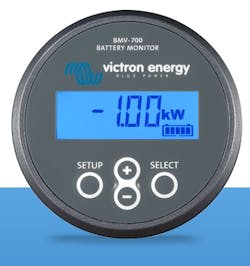Dethleffs, a well-known German motor home manufacturer, did a concept study of an electrically driven motor home. They were convinced on its viability, stating that: “Electric drive for motor homes will play a great role in the future even if the implementation won’t be as quick as in the car sector.” This study evolved into the company’s e.home concept.
The e.home concept implements a fully-electric powertrain that depends only on solar power as its primary energy source. Thus, this concept motor home with electric drive also supplies all onboard services with electricity for the living area. Dethleffs also came up with several new electric technologies that can change the comfort, quality of life, and safety of future-generation motor homes. The e.home concept became a reality as it was exhibited at the Caravan Salon Düsseldorf in September 2017.
Dethleffs covers nearly every inch of the e.home in solar panels, helping to keep the electric battery powered up. (Credit: Dethleffs)
Dethleffs chose the Iveco Daily Electric chassis that has several battery options and offers a range of up to 174 mi (280 km). However, Dethleffs suggests the e.home range might be closer to 103 miles (167 km).
The e.home uses solar panels to charge FIAMM sodium nickel chloride batteries that have a capacity of 3 × 76 Ah at 400 V. These can be recharged up to 1,500 times, which would cover a distance of about 250,000 km. Battery performance is improved by supercapacitors that provide faster recharge and delivery of the electrical energy. This increases the performance of the vehicle as well as the battery lifecycle. The batteries supply power to a liquid-cooled three-phase 107 hp, 80kW AC drive motor as well as other motor home electrical loads.
These batteries have sodium and nickel as active materials and a solid ceramic electrolyte, and all cells are contained in a sealed steel sheet. Typical failure modes, such as an internal short, do not cause a violent energy release; instead batteries remain in operation with slight loss of performance. An integrated battery management system (BMS) provides diagnostics alerts on anomalies and disconnects the battery in case of serious failure. In the event of BMS failure, an independent supplementary circuit protects the battery.
Battery Features
- Constant performance at -20° to +60°C
- 58V per cell
- 140 Wh/kg specific density
- No cooling required >2000 cycles at 80% DoD
- 100% maintenance free operation
- Allows remote monitoring
- Integrated low voltage disconnect (LVD)
- Integrated battery monitoring system (BMS) provides monitoring, diagnostics and data logging.
- Specific energy 70% lighter and 30% smaller than conventional batteries
- Long shelf live
- Capacity to store energy indefinitely when not connected
- No outgassing and zero ambient emission
A battery “fuel gauge,” time-to-go indicator, is part of the e.home system. The fuel gauge shows the remaining battery capacity, which depends on the ampere-hours consumed, discharge current, temperature, and the age of the battery. Complex software algorithms take all these variables into account. Next to the basic display options, such as voltage, current, and ampere-hours consumed, the Victron BMV-700 series also displays state of charge, time to go, and power consumption (Fig. 2). Another “gauge,” the BMV-702, features an additional input that you can program to measure the voltage (of a second battery), battery temperature or midpoint voltage.
A “fuel gauge” displays state of charge, time to go, and power consumption.
Solar Power
Dethleffs' e.home has 31 square meters of optimized thin-film solar cells, which provide about 3,000 watts of peak power to keep the 228-Ah sodium-nickel-chloride battery array charged.
Its key components include:
- Solar charge controllers to harvest solar energy.
- A combined inverter/charger for onboard ac electricity and charging of the lithium domestic power storage batteries.
- Required ancillaries, which include battery safety protection, system monitoring and the e.home heating power supply.
- A dc-dc converter ensures that all 12V, USB accessories, tablets, smartphones etc., can be supplied and charged.
Victron’s SmartSolar Maximum Power Point Tracking (MPPT) system supports the solar panels. For a cloudy sky or partial shading, light intensity changes continuously, so an ultra-fast MPPT controller improves energy harvest. An algorithm maximizes energy harvest by locking to the optimum MPP. Among its features are:
- Fully programmable charge algorithm and eight pre-programmed algorithms, selectable with a rotary switch.
- Over-temperature protection and power derating when temperature is high.
- PV short circuit and PV reverse polarity protection.
- PV reverse current protection.
- Internal temperature sensor compensates absorption and float charge voltage for temperature.
The SmartSolar Charge Controller.
Heating, Cooking, and Refrigeration
Heating is often the most intensive use of energy in a motor home. When changing to an electric heating system, Dethleffs’ developers had to find a new, even unconventional solution to generate a pleasant warm feeling with as little energy use as possible.
To achieve this, several latent heat accumulator plates made of phase change material (PCM) were installed in several places. These heat accumulators absorb energy at temperatures over 26°C and deliver it when the temperature goes down in the evening hours. Additionally, heating elements are also mounted in the floor, sidewalls and furniture that heat the interior via infrared warmth sources, but only the objects they reach—not the air. This is efficient yet still creates a cozy warm feeling, although the general room temperature is at 2 to 3 degrees lower than with traditional heating systems. Infrared warmth is available without any pre-heating time.
The e.home also includes a ceramic stove with three cooking stations as well as an energy-efficient compressor refrigerator.
Quality of life features include a special foil technology that you can use as a mirror, when switched on it spreads a bright, planar light. Another interesting feature is the electric window blind. This is a foil, that is set between the window panes of the insulated windows, which can be electrically dimmed as a protection from the sun and intense heat, as well as also being able to serve as a privacy screen.
Dethleffs exhibited the e.home concept motor home at Caravan Salon Düsseldorf 2017. (Credit: Messe Düsseldorf/Constanze Tillmann).
Connectivity
Dethleffs placed great importance when it comes to connectivity. Smart homes and IoT are fast evolving trends of the present, which are having more and more impact, offering new possibilities for comfort and safety. The basic prerequisite for the “smart motor home” therefore is the digitization and connection of the installed components in the vehicle.
Dethleffs’ e.home has an integrated system installed called CampConnect, which enables connectivity of general components and is able to digitize almost all components in the motor home. You can operate this connectivity by an installed app on your tablet. These operation and display possibilities are there for heating, light and power.
An innovative safety system is installed in the e.home. Called “Mobileye,” it supports the driver in the form of a “third eye” in order to keep track of situations in front of the vehicle. It identifies potential dangers on the road and forewarns the driver by acoustic and optical signals.
About the Author

Sam Davis
Sam Davis was the editor-in-chief of Power Electronics Technology magazine and website that is now part of Electronic Design. He has 18 years experience in electronic engineering design and management, six years in public relations and 25 years as a trade press editor. He holds a BSEE from Case-Western Reserve University, and did graduate work at the same school and UCLA. Sam was the editor for PCIM, the predecessor to Power Electronics Technology, from 1984 to 2004. His engineering experience includes circuit and system design for Litton Systems, Bunker-Ramo, Rocketdyne, and Clevite Corporation.. Design tasks included analog circuits, display systems, power supplies, underwater ordnance systems, and test systems. He also served as a program manager for a Litton Systems Navy program.
Sam is the author of Computer Data Displays, a book published by Prentice-Hall in the U.S. and Japan in 1969. He is also a recipient of the Jesse Neal Award for trade press editorial excellence, and has one patent for naval ship construction that simplifies electronic system integration.
You can also check out his Power Electronics blog.




